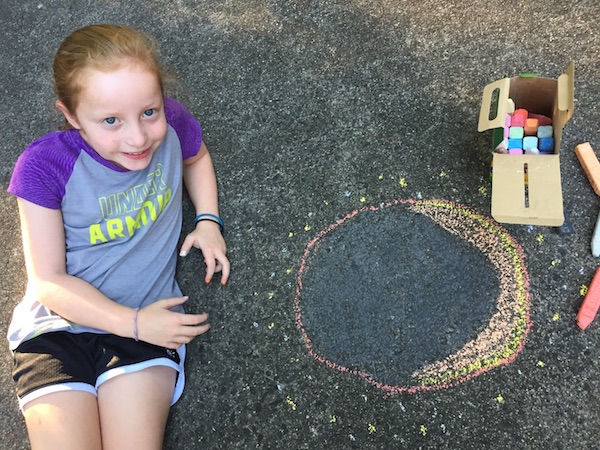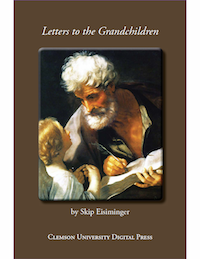Darkness at 14:37 EDT: Eclipse
“As the temperatures climbed back into the 90s following the recent eclipse, I was struck by the fact that the entire enterprise is riding on loose rock. I walked off testing the ground like a novice hiker probing a marsh, a blind man tapping out an unfamiliar route.” —Skip Eisiminger
Skip the B.S.
By Skip Eisiminger

“The sun keeps all the planets on their appointed rounds, yet somehow manages to ripen a bunch of grapes as if it had nothing else to do.”—Galileo Galilei, c.1600
“Who would place this lamp in another . . . position than that from which it can light up the whole system simultaneously?”—Nicolaus Copernicus, 1543
 CLEMSON South Carolina—(Weekly Hubris)—November 2017—Halfway through the sun’s projected lifespan of ten billion years, our star still hoards 99.9 percent of everything in the solar system. How a concentration of gas can burn so long and still hold Pluto in its orbit while ripening all the grapes in Concord escapes me. The problem, of course, is mine because the sun and its light do both and much more.
CLEMSON South Carolina—(Weekly Hubris)—November 2017—Halfway through the sun’s projected lifespan of ten billion years, our star still hoards 99.9 percent of everything in the solar system. How a concentration of gas can burn so long and still hold Pluto in its orbit while ripening all the grapes in Concord escapes me. The problem, of course, is mine because the sun and its light do both and much more.
Despite its lengthy expenditures, our “yellow dwarf” is still large enough to contain 1.3 million Earths. Indeed, it is this barely conceivable magnitude which accounts for the 4.3 pounds of sunlight striking the Earth each day, the five million neutrinos per second that fly through every square centimeter of the Earth’s surface, and the ninety billion hydrogen bombs exploding at its core every second. However, given that the sun has made only 20 revolutions around the black hole at the center of our galaxy, as stars go, it’s a mere youth.
During the four hours that the moon blocked the sun across the US on August 21, 2017, the solar energy lost was enough to power two million homes for a day and cost the nation nearly $700 million in productivity. But for most of the 40 million who took some time off from work to witness the totality, the eclipse was a rare moment to cheer. From alt-right to alt-left, we’d finally found a common bond. On this memorable “Sun-day” (which fell on “Moon-day”), I found myself moved to tears by the reappearance of the sun.
After an editor pointed out to Eudora Welty that the moon rises in the east, she wrote, “It’s important to get your moon in the right part of the sky.” As writerly advice, she meant that, of course, in its broadest sense, but it is true that little Luna is underappreciated, especially when contrasted to Father Sol. But consider this: had there been a massive solar flare during the 2017 eclipse, there would have been nothing to protect us but our solitary moon. Jupiter has 67 of these guardians, and large as this aggregate is, it and others offer Earth some measure of protection from threats emanating beyond the solar system. But because of their proximity, the moon and our atmosphere are our most reliable defenders.
With a diameter 400 times shorter than the sun’s, the moon is also four hundred times closer. It is this coincidence that makes a total eclipse possible. But since our younger cousin, which was blasted out of the basin that is today the Pacific Ocean, is being drawn away from us by the sun at a rate of about 2 inches a year, solar totality as we saw it in 2017 will one day cease.
It was once thought that the moon, “a Presence to glop at,” as W.H. Auden observed, influenced everything from menstrual cycles to mental health. Now we know that moon-induced tides expedited life on Earth as well as the progress we call evolution. It is the moon that lifts the surface of the Earth 19.5 inches with every pass, lightening our step, and creaking old floorboards.
Twelve of our species have trod the moon’s surface, returning from their six expeditions with 850 pounds of dust and rock. But many of these intrepid voyagers laid their geocentrism at the feet of heaven’s queen. Standing in an arid sea, many of them accepted their marginal position in the universe as their egos evaporated with the illusion that Earth is central in all but the narrowest terrestrial sense.
The Greek root at the heart of eclipse is “abandoned,” for that is surely how early man felt when the sun went dark at midday. But, for the most part, the effects observed on August 21, 2017 did not reflect a sense that life was being abandoned by the celestial king who warmed the waters that gave us life. Indeed, for many creatures, the eclipse seemed like Nature’s prank on the gullible. As temperatures dropped 11 degrees, and light dimmed to sepia:
- insects paused from their work,
- dogs circled their beds;
- birds flew to their nests;
- fish took the bait;
- chickens went to roost;
- baboons grew listless;
- camels huddled;
- and leaf shadows turned to crescents.

For humans, it was as if 40 million of us were invited to our parents’ wedding. Under a wreath of wedding-white, the Creator gave us His blessing.
For all of man’s recorded history, and we can safely assume the unrecorded portions as well, eclipses have captured our attention and imagination:
- In 2,500 BC, the Chinese concluded the moon was “eating the sun” but were undecided if she excreted her meal or regurgitated it.
- Like their Chinese neighbors, Hindu astronomers also saw an eclipse as a celestial meal but concluded the moon just spit the indigestible portion out.
- Though the Babylonians learned as early as 1,150 BC that eclipses follow a predictable order, they never lost their fear. “Darkness at noon” surely was an ominous sign because even the youngest understood that darkness foretold a stubbed toe or worse. The potential for harm was so obvious that prior to one eclipse, a Babylonian king appointed one of his priests “king for the day.”
- In 585 BC, the warring Lydians and Medes studied an eclipse, decided it was a mandate for peace, and went home.
- Various aboriginal people have been known to shoot flaming arrows at the sun to reignite it or merely kill the invading moon. Others have read it as a sign to procreate.
Though Edmund Halley confidently reported in 1717 that the sun’s “suddain darkness” offered no threat to King George or human affairs in general, the news has not yet reached all quarters. As late as the 19th century, the sun was thought by many to be a lump of burning coal, and women were considered too weak to study it. Following the solar eclipse in February of 1831, upstate South Carolina church rolls added thousands of frightened worshipers and 13 new churches. During the 1878 eclipse in the American west, casket and cemetery-plot salesmen did a brisk business. In 1979, the first solar eclipse I witnessed, a young Baptist in nearby Anderson, SC jumped from his tractor and cowered between two furrows, assured that the rapture had begun. Fundamental Christian leaders exploited the same belief in 2017 claiming that the August eclipse was proof that “we are living in the last days.” Congregations were told, “Jesus may be on his way,” though some did not hear or understand that modal auxiliary.
As the temperatures climbed back into the 90s following the recent eclipse, I was struck by the fact that the entire enterprise is riding on loose rock. I walked off testing the ground like a novice hiker probing a marsh, a blind man tapping out an unfamiliar route.
A day later, however, having regained my confidence in celestial mechanics, I decided that if a full moon is reason to howl, a solar eclipse should be a holy day for all God’s sublunary and subsolar creatures.

Author’s Note: Thanks to Miss Lena Fraiser, my granddaughter and muse, who framed this project.

To order copies of Skip Eisiminger’s Letters to the Grandchildren (Clemson University Digital Press), click on the book cover below or contact: Center for Electronic and Digital Publishing, Strode Tower, Box 340522, Clemson SC 29634-0522.



2 Comments
diana
Thank you, Skip, for a lovely dissertation on this eclipse and ones in the past. It’s been so long since I’ve seen one and you and Anita have helped me sort of experience it.
Skip Eisiminger
Thanks, Diana.
This was my first total eclipse, I think, and while I joked about it, it felt like the sky was falling. Chicken Little was right to be afraid! Skip